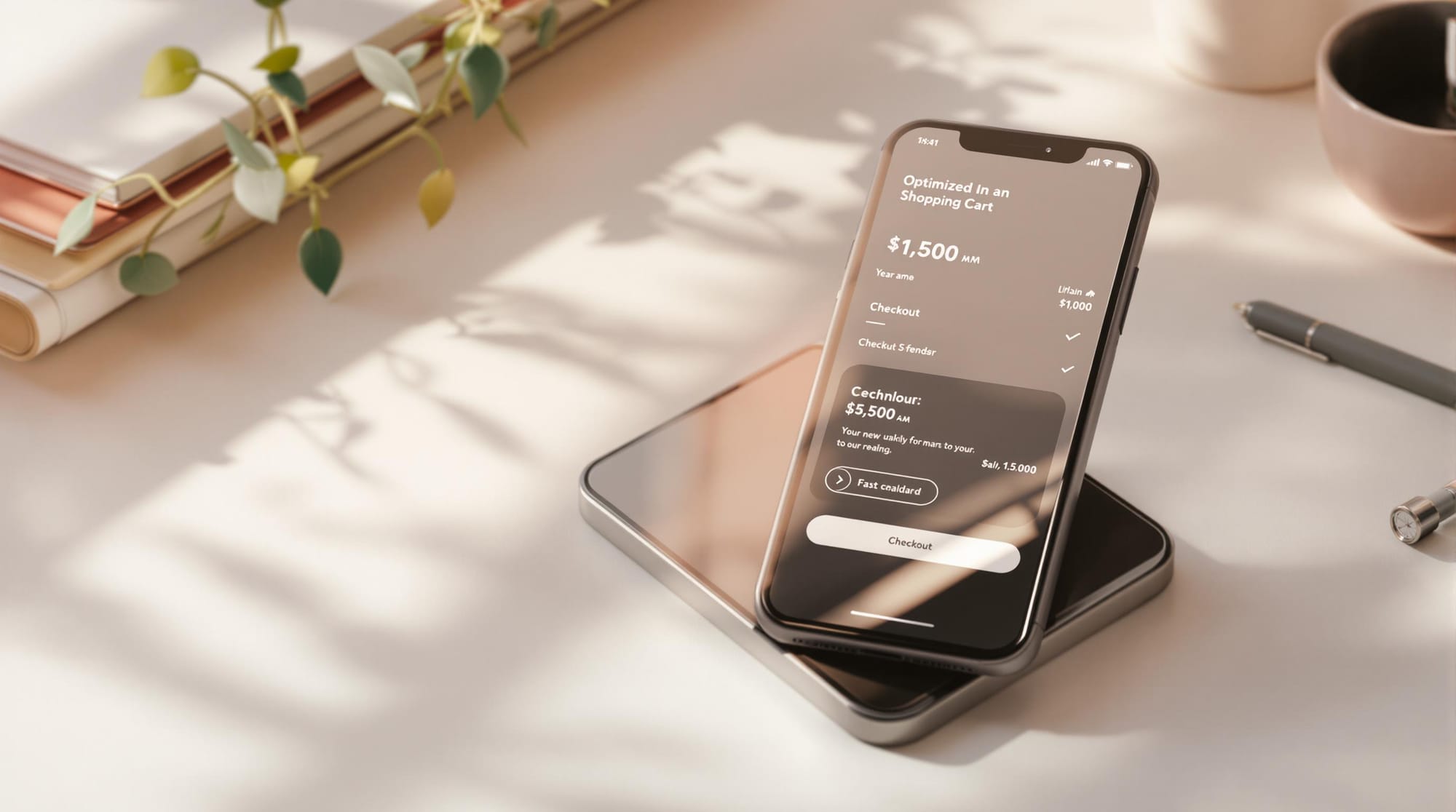How to Optimize Shopify Carts for Mobile
Optimize your Shopify cart for mobile with design simplifications, faster loading speeds, and streamlined checkout to boost sales.

Mobile shopping is now the norm. If your Shopify cart isn’t optimized for mobile users, you’re losing sales. Here's how to fix that:
- Simplify Design: Use responsive layouts, big buttons, and clear product details.
- Speed Up Loading: Optimize images, compress code, and use caching.
- Streamline Checkout: Enable guest checkout, autofill forms, and offer mobile-friendly payment methods like Apple Pay and Google Pay.
- Add Key Features: Fixed cart buttons, side cart displays, and real-time stock updates keep users engaged.
How to Upgrade Your Shopify Cart Page with Shop Cart Canvas

Building Better Mobile Cart Layouts
Designing a mobile cart layout that works well requires simplicity and user-focused features. According to data from Cart Drawer & Cart Upsells for Shopify, a well-optimized mobile cart can cut down on cart abandonment. Let’s dive into the key elements of creating a better mobile cart experience.
Mobile Cart Design Basics
A mobile-friendly cart begins with a responsive design. This means layouts that adjust smoothly to different screen sizes, with text and images that scale properly for easy reading.
Key elements to include:
- Large, touch-friendly buttons and links for easier navigation
- Quick-loading product images to reduce wait times
- Clear product details with enough spacing for readability
- Visible total price and shipping info to avoid surprises
Mobile-Ready Buttons and Forms
Touch-friendly buttons and well-designed forms make a big difference. Research shows that reducing friction here improves the user experience. Highlight primary buttons, use adequate spacing for form fields, and ensure quantity adjusters are intuitive and easy to use.
Clean Mobile Interface Design
Keep the interface simple and focused on what matters most. Here’s how:
- Show only the essentials: product name, price, quantity, and an image.
- Use a single-column layout so users can scan the page easily.
- Keep the checkout button always visible - no scrolling required.
- Provide clear visual feedback when users take actions like adding or removing items.
Speed Up Your Mobile Cart
A fast-loading mobile cart is just as important as having a clean design. Quick loading times improve user experience and drive more conversions. To achieve this, focus on optimizing images and streamlining your code.
Mobile Image Optimization
Efficiently optimized images can significantly reduce page load times. Here's how to do it:
- Use adaptive image sizing to deliver images tailored to different device screens.
- Implement lazy loading so only on-screen content loads immediately.
- Convert images to modern formats like WebP for better quality at smaller sizes.
- Compress product thumbnails to minimize file size while keeping them sharp.
These steps help reduce your page's weight without compromising image quality.
Code and Cache Setup
Caching and code optimization are essential for improving speed. Here's what to focus on:
- Caching Static Assets: Store images, CSS, and JavaScript locally with set expiration dates to minimize repeated downloads.
- Enable Compression: Compress text-based assets like HTML, CSS, and JavaScript to save bandwidth.
- Local Storage for Cart Data: Use local storage to keep cart data accessible without constant server requests.
When it comes to code:
- Minify CSS and JavaScript files to remove unnecessary characters.
- Eliminate unused code to keep things clean and efficient.
- Combine files to reduce the number of HTTP requests.
Once you've optimized your code, ensure critical elements load first to improve usability.
Loading Speed Priorities
Prioritize loading the most important cart elements first, like the cart total and checkout button, so users can interact with them immediately. Secondary elements can load shortly afterward.
To further enhance speed, consider using a Content Delivery Network (CDN). A CDN distributes your store's content across multiple servers worldwide, ensuring faster and more consistent loading times for users, no matter where they're located.
Mobile Checkout Updates
Making the mobile checkout process smoother can directly influence your store's performance. Small changes, from refining cart design to improving checkout, can make a big difference.
Shorter Checkout Forms
Keep forms simple by asking only for what’s necessary:
- Combine first and last name fields into one.
- Use smart address tools that auto-complete shipping details.
- Enable browser autofill to speed up form completion.
Quick Guest Checkout
A guest checkout option removes obstacles for mobile shoppers. It allows users to buy without creating an account. To make it even better:
- Highlight the guest checkout option on your site.
- Let customers create an account after they’ve purchased.
- Save guest details to simplify future purchases.
Mobile Payment Options
Shoppers today want payment methods that are both easy and secure. Add popular digital payment options to meet their expectations:
| Payment Method | Benefit |
|---|---|
| Apple Pay | One-tap payment |
| Google Pay | Auto-filled details |
| PayPal | Trusted security |
| Shop Pay | Pre-saved info |
| Buy Now, Pay Later | Flexible payment plans |
Offering these payment methods makes checkout faster and more convenient, improving the overall mobile shopping experience.
Mobile Cart Features That Work
Boost your mobile store's performance with tools designed to make shopping easier and increase checkout success.
Fixed Cart Buttons
Fixed cart buttons can help shoppers complete their purchases more easily. Here’s how to make them work for you:
- Place the button in the bottom-right corner for easy access.
- Use bold, contrasting colors to make it stand out.
- Display a live cart count to keep users informed.
- Ensure the button size is at least 44x44 pixels for easy tapping.
- Add a small animation when items are added to the cart for visual feedback.
Side Cart Display
A side cart lets customers check their cart without leaving the page, keeping the shopping flow uninterrupted. This feature can make the experience smoother and more engaging.
To make your side cart effective:
- Enable swipe gestures for quick opening and closing.
- Clearly show product images, quantities, and prices.
- Include a running subtotal at the bottom.
- Add shipping progress indicators to keep customers informed.
- Offer one-tap checkout options for faster conversions.
A responsive side cart ensures it looks great on any screen size.
Stock Level Updates
Real-time stock updates can encourage faster decisions and help shoppers plan their purchases. Use these strategies:
- Show low stock alerts to highlight items that might sell out soon.
- Include inventory countdowns to display the exact number of units left.
- Allow customers to save items for later to keep them engaged.
Make stock levels visible during product browsing, in the cart summary, at checkout, and near related items. These updates keep your mobile cart efficient and sales-focused.
Conclusion: Mobile Cart Success Steps
To wrap up your mobile cart improvements, let’s revisit the essential strategies and steps to ensure your cart is optimized for success.
Key Areas to Focus On
Improve your mobile cart by concentrating on these critical aspects:
- Responsive Design: Make sure your cart adjusts perfectly to any screen size.
- Fast Loading Speeds: Reduce load times to keep users engaged.
- Clear Navigation: Use fixed cart buttons and side-cart displays for better usability.
- Real-Time Updates: Show accurate stock levels instantly.
- Streamlined Checkout: Include guest checkout and mobile payment options for convenience.
Steps to Get Started
1. Audit Your Current Setup
Take a close look at your mobile cart's performance. Check metrics like load times, conversion rates, and abandonment rates. Use tools to identify problem areas and opportunities for improvement.
2. Make High-Impact Updates
Start with changes that will bring immediate results. For instance:
- Add dynamic free shipping bars to encourage higher order values.
- Use personalized cart reminders to re-engage potential buyers.
- Implement a zero-redirect checkout to simplify the process.
3. Track and Improve Over Time
Keep an eye on important metrics, such as:
- Cart abandonment rate
- Average order value
- Time taken to complete checkout
- Mobile conversion rate
Regular monitoring and adjustments will help you create a smoother, more effective mobile shopping experience.
